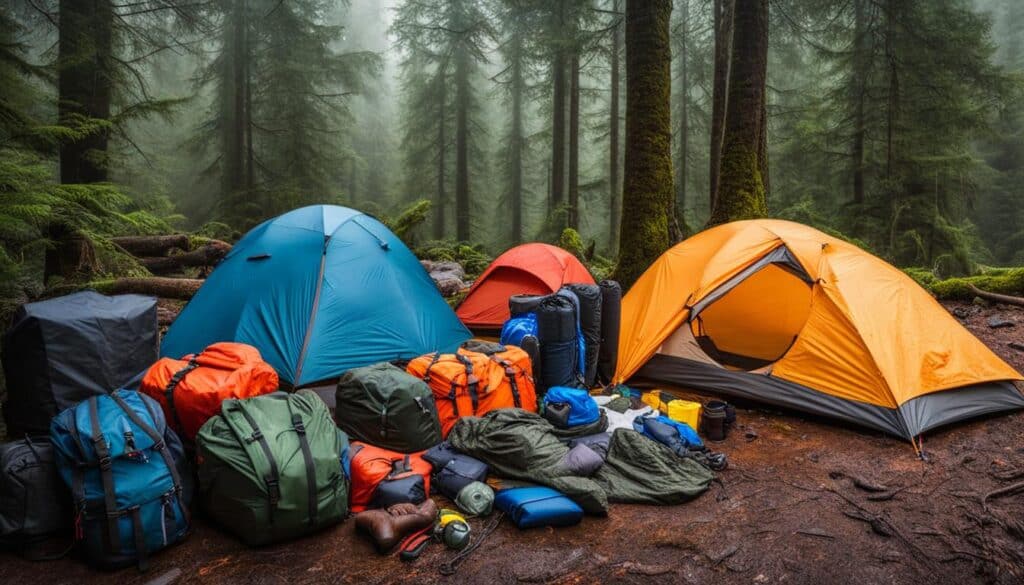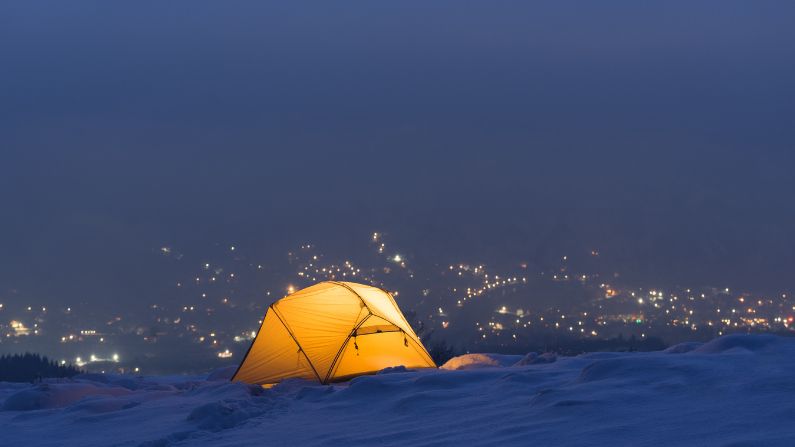Camping in the rain can be a unique and exhilarating experience, but proper preparation is key to ensure a successful and enjoyable trip. In this article, I will share expert tips and advice for camping in the rain, including gear recommendations, choosing the right campsite, staying dry with appropriate clothing, and ways to brighten up your rainy nights. Let’s dive in and learn how to embrace the adventure of camping in the rain!
Prepare for Camping in the Rain
Before embarking on your rainy camping adventure, it’s crucial to take some preparatory steps to ensure a successful and enjoyable experience. Proper preparation starts with having the right gear. Here are some essential items to consider:
- Waterproof tent: Invest in a high-quality tent designed specifically for wet weather camping. Look for a tent with a waterproof rating and a sturdy rainfly to ensure maximum protection from the elements.
- Waterproofing spray: Treat your tent with a waterproofing spray to enhance its ability to repel water. This extra layer of protection can make a significant difference in keeping you dry during rainy conditions.
- Extra tarps and ground cloths: Bring along extra tarps and ground cloths to create additional coverage for your campsite. These can be used to create a dry space outside your tent, as well as protect your gear from moisture.
In addition to your gear, it’s important to check the camping forecast for your desired destination. Knowing the expected weather conditions will help you plan and prepare accordingly. Look for any potential storms or heavy rainfall and adjust your camping plans if necessary. Pitch your tent on higher ground to avoid pooling water and potential flooding. It’s also a good idea to choose a campsite with good drainage to minimize the risk of water accumulation.
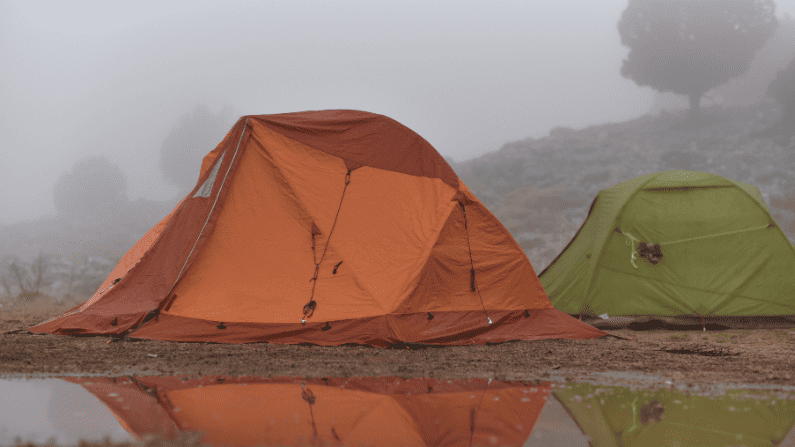
Packing rain gear and adequate lighting is also essential for camping in the rain. Make sure to bring waterproof jackets, pants, and footwear to keep yourself dry and comfortable. Don’t forget to pack extra towels to wipe off any moisture and ensure you have proper lighting to brighten up your campsite during the rainy nights.
Benefits of Waterproof Gear
Investing in high-quality waterproof gear is crucial when camping in the rain. It not only keeps you dry and comfortable but also protects your health and safety. Wet clothes can lead to hypothermia and increase the risk of developing cold-related illnesses. With waterproof gear, you can fully enjoy the outdoor experience without worrying about getting soaked or feeling uncomfortable.
| Waterproof Tent | Rainfly | Waterproofing Spray |
|---|---|---|
| Provides maximum protection from rain and moisture | Acts as an extra layer of protection for your tent | Enhances the water-repellent properties of your tent |
| Keeps you dry and comfortable throughout your camping trip | Helps prevent water from seeping through the tent fabric | Protects your tent from water damage |
| Offers peace of mind during inclement weather | Provides added coverage for your tent and campsite | Easy to apply and significantly improves waterproofing |
By taking the necessary precautions and having the right gear, you can be well-prepared for camping in the rain. With a waterproof tent, proper waterproofing spray, and extra tarps, you can stay dry and comfortable throughout your adventure. Don’t let the rain dampen your spirits – embrace the experience and create unforgettable memories in the great outdoors.

Choose the Right Campsite That can Survive a Rainy Day
When it comes to camping in the rain, selecting the right campsite is crucial for a safe and enjoyable experience. Whether you’re camping in national parks or exploring more remote wilderness areas, there are several factors to consider in order to find a campsite that can withstand rainy conditions and keep you comfortable and dry.
Designated Campsites in National Parks
If you prefer camping in established areas, national parks offer designated campsites that are equipped to handle rainy weather. Look for campsites with designated tent pads and infrastructure that can withstand rainfall. These campsites often have proper drainage systems and well-maintained facilities to ensure a more comfortable camping experience, even during wet conditions.
Tree Tents for Adventure Seekers
For the more adventurous camper, consider using a tree tent for camping in the rain. Tree tents provide an elevated camping experience, keeping you off the damp ground and away from potential flooding. They offer a unique perspective and the opportunity to camp in areas that may not be suitable for traditional tents. Just make sure to choose sturdy trees and follow the manufacturer’s instructions for proper setup and safety.
Choose a suitable campsite location on higher ground
When camping in the rain, one of the most important considerations is finding the right campsite location. Look for higher ground to avoid potential pooling of water around your tent. Avoid areas with obvious signs of water accumulation such as depressions or dips in the terrain.
Ideally, choose a spot that is slightly elevated to ensure proper drainage during heavy downpours. By selecting a higher ground, you’re already taking a significant step towards staying dry and comfortable throughout your camping experience.
Take Advantage of surroundings
Take advantage of nature’s offerings and let them serve as protective allies during unpredictable weather conditions. By following these tips for setting up camp in the rain, you’ll be better equipped to handle wet conditions successfully while ensuring a relatively dry and comfortable camping experience amidst nature’s showers.
If you would like more information on camping in adverse conditions read this article: Camping In The Wind.
| Pros | Cons |
|---|---|
| Designated campsites in national parks offer infrastructure and amenities that can withstand rainy conditions. | Availability of designated campsites may be limited, especially during peak camping seasons. |
| Tree tents provide a unique and elevated camping experience, keeping you off the damp ground and away from potential flooding. | Setting up a tree tent requires careful selection of sturdy trees and may not be suitable for all camping locations. |
| Finding natural shelters like trees or large leafy canopies can provide cover from rain and create a more comfortable camping environment. | Reliance on natural shelters may limit campsite options and may not always be available in certain locations. |
By choosing the right campsite that can survive a rainy day, you can enhance your camping experience and ensure a more enjoyable adventure in the great outdoors. Remember to always prioritize safety and follow Leave No Trace principles to minimize your impact on the environment.
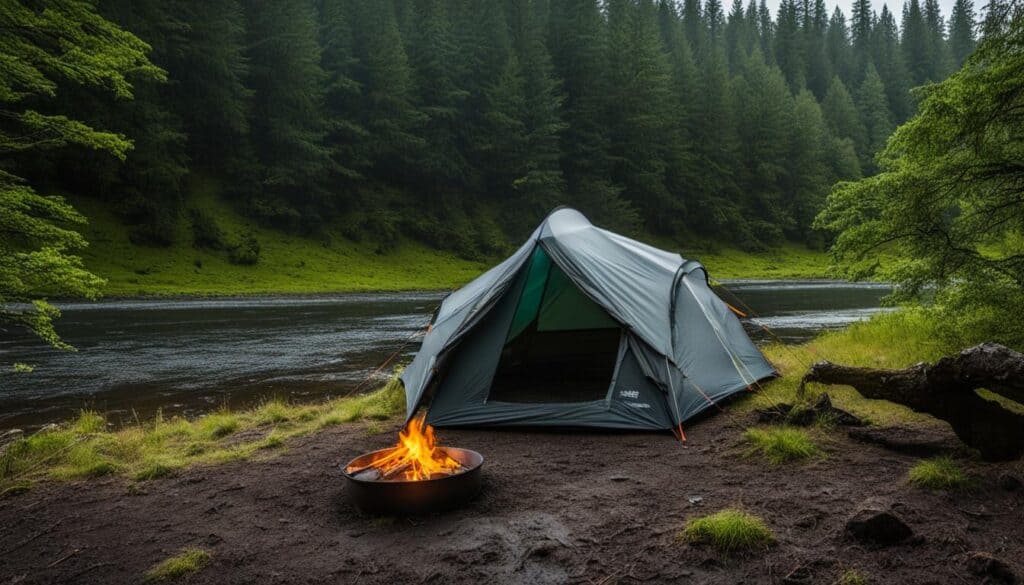
Camp In The Rain With Appropriate Clothes
Camping in the rain requires proper clothing to ensure you stay dry and comfortable throughout your adventure. By choosing the right rain gear and layering system, you’ll be well-equipped to handle any wet conditions that come your way.
To truly embrace bad weather camping, you’ll want to invest in some top-notch waterproof clothing. An essential part of your camping attire is a reliable waterproof jacket. Look for a jacket with taped seams and ventilation features to keep you dry while allowing for breathability. Opt for a jacket made from high-quality materials that can withstand heavy rain. You will also want to pair it with waterproof pants that fit comfortably over your regular hiking pants or shorts.
To ensure maximum comfort, consider using a layering system. Start with a wool base layer for its moisture-wicking properties and insulation even when wet. Layer on polyester mid-layers for added warmth and to further regulate your body temperature. This combination of fabrics will keep you comfortable even in wet conditions.
Don’t forget about your feet! Invest in waterproof boots to keep your feet dry while exploring the outdoors. Pack extra pairs of socks to change into when needed. A wide-brim hat will help keep rain off your face, and it’s always a good idea to have a spare dry hat in case yours gets soaked.
By dressing appropriately with the right rain gear and layers, you can stay dry and make the most of your rainy camping trip.
Stay Dry Checklist:
- Waterproof jacket with taped seams and ventilation
- Wool base layers for moisture-wicking and insulation
- Polyester mid-layers for temperature regulation
- Waterproof boots
- Extra pairs of socks
- Wide-brim hat
| Item | Description |
|---|---|
| Waterproof Jacket | A reliable jacket with taped seams and ventilation features to keep you dry in the rain. |
| Wool Base Layers | Moisture-wicking and insulating base layers made of wool to keep you warm even when wet. |
| Polyester Mid-Layers | Mid-layers made of polyester for added warmth and temperature regulation in wet conditions. |
| Waterproof Boots | Boots designed to keep your feet dry and protected from rain and puddles. |
| Extra Socks | Additional pairs of socks to change into when your current ones get wet. |
| Wide-Brim Hat | A hat with a wide brim to keep rain off your face and head. |
Remember, camping in the rain can be an adventure in itself. With the right clothing, you can stay dry and comfortable, allowing you to fully embrace the experience of camping in wet weather.
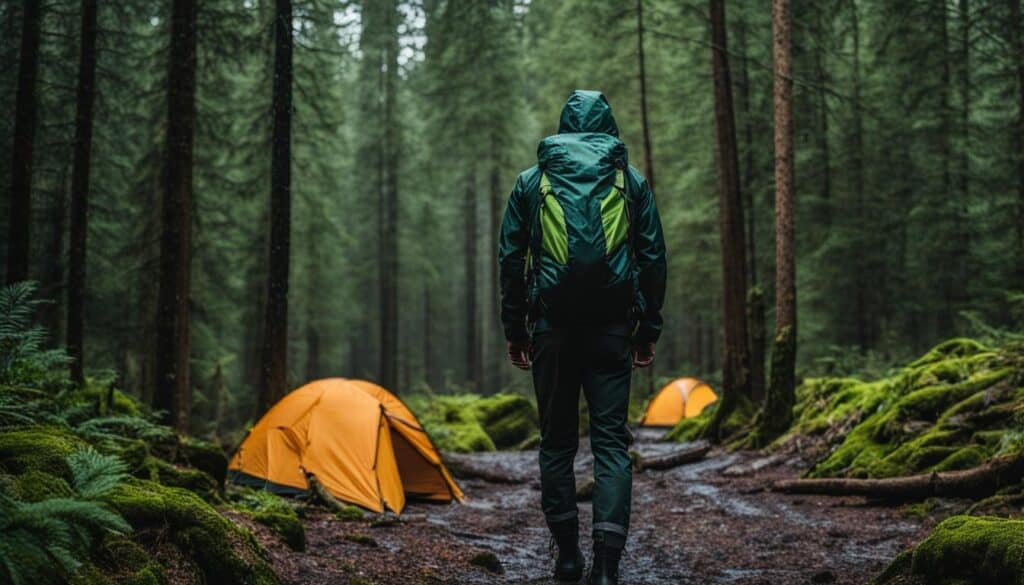
Camping in the Rain Hacks to Brighten Up The Night
Rainy nights can create a gloomy atmosphere during camping trips, but with some clever hacks, you can brighten up the darkness and make your experience more enjoyable. By incorporating different lighting options, you can create a cozy and inviting ambiance in and around your campsite. Let’s explore some creative ways to light up your rainy nights:
- String Lights: One of the most popular lighting options for camping, string lights can add a magical touch to your campsite. Hang them around your tent or attach them to nearby trees to create a warm and inviting atmosphere. Opt for waterproof string lights to ensure they withstand the rain.
- Solar Lanterns: For an eco-friendly lighting option, consider using solar lanterns. These lanterns charge during the day using solar power and provide bright, long-lasting illumination at night. Place them strategically around your campsite for optimal lighting.
- Multi-Color Lanterns: If you want to add a splash of color to your campsite, multi-color lanterns are a great choice. These lanterns come in various shades and can create a playful and cheerful ambiance. Hang them in trees or place them on tables to add a vibrant touch to your rainy nights.
By incorporating these lighting options, you can transform a rainy night into a magical experience. Whether you prefer the enchanting glow of string lights, the eco-friendly illumination of solar lanterns, or the vibrant colors of multi-color lanterns, there is a lighting option to suit every camper’s preference. Brighten up your rainy nights and create unforgettable memories under the rain-kissed sky.
Table: Comparison of Camping Lighting Options
| Lighting Option | Advantages | Disadvantages |
|---|---|---|
| String Lights | Creates a cozy and inviting ambiance, versatile placement options | Requires a power source or batteries, can be affected by heavy rain |
| Solar Lanterns | Eco-friendly, no need for batteries, long-lasting illumination | Relies on sunlight for charging, may have limited brightness during cloudy days |
| Multi-Color Lanterns | Adds vibrancy and playfulness to the campsite, variety of colors available | May not provide as much brightness as other options, limited color options |
Note: The table above provides a comparison of different camping lighting options based on their advantages and disadvantages. It aims to help you make an informed decision when choosing the right lighting option for your rainy camping adventure.
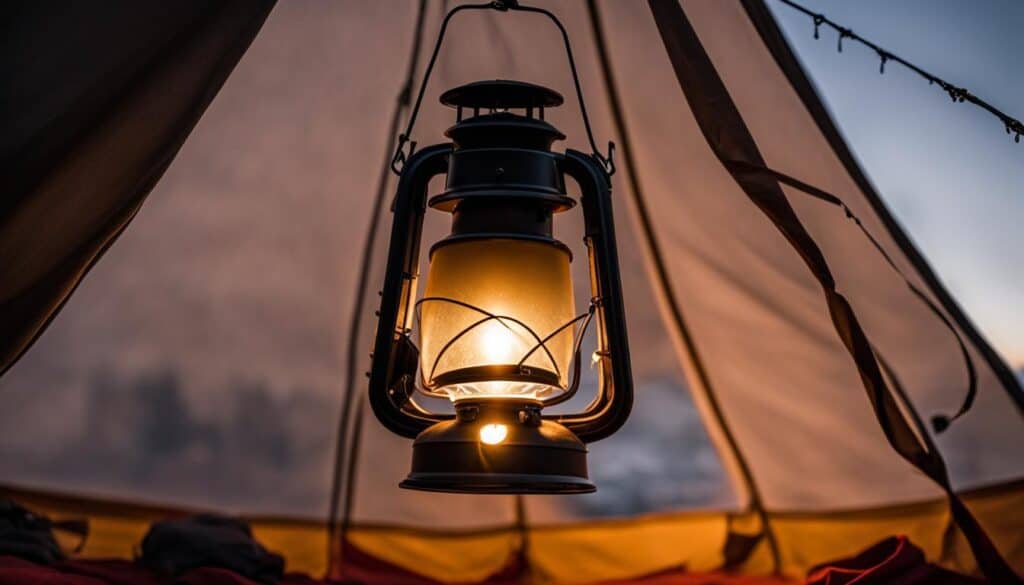
With the right lighting, you can transform a rainy night into a magical experience. Enhance the atmosphere of your campsite, create a cozy ambiance, and make unforgettable memories under the rain. Choose your preferred lighting option and make the most of your camping adventure, even in wet conditions.
Check The Weather Forecasts
Before embarking on your rainy camping trip, it’s important to check the weather forecasts to stay informed and prepared. Knowing what to expect can help you make the necessary adjustments and ensure a safer camping experience. Pay attention to the forecasted precipitation, wind speeds, and any severe weather warnings that may be in effect. Planning your activities and packing accordingly will contribute to a more enjoyable and comfortable trip.
If there’s a forecast for thunderstorms or other severe weather conditions, it’s best to postpone your camping trip. Camping during thunderstorms can be dangerous due to the risk of lightning strikes and strong winds. It’s essential to prioritize your safety and the safety of your fellow campers. Keep in mind that weather conditions can change rapidly, so stay updated on the latest forecasts and make informed decisions based on the information available.
When camping in inclement weather, remember to pack appropriate gear such as waterproof clothing, sturdy tents with rainfly covers, and waterproof footwear. Additionally, bring extra tarps and ropes to create additional sheltered areas for cooking or relaxing. Always be prepared for unexpected weather changes and have a plan in place for seeking shelter if necessary.
“Being well-informed about the weather conditions before your camping trip can make all the difference in ensuring your safety and enjoyment.”
By staying updated on the weather forecasts and adequately preparing for the conditions you may encounter, you can make the most of your camping experience, even in the rain. Remember to stay safe, stay dry, and embrace the unique adventure that camping in inclement weather can bring.
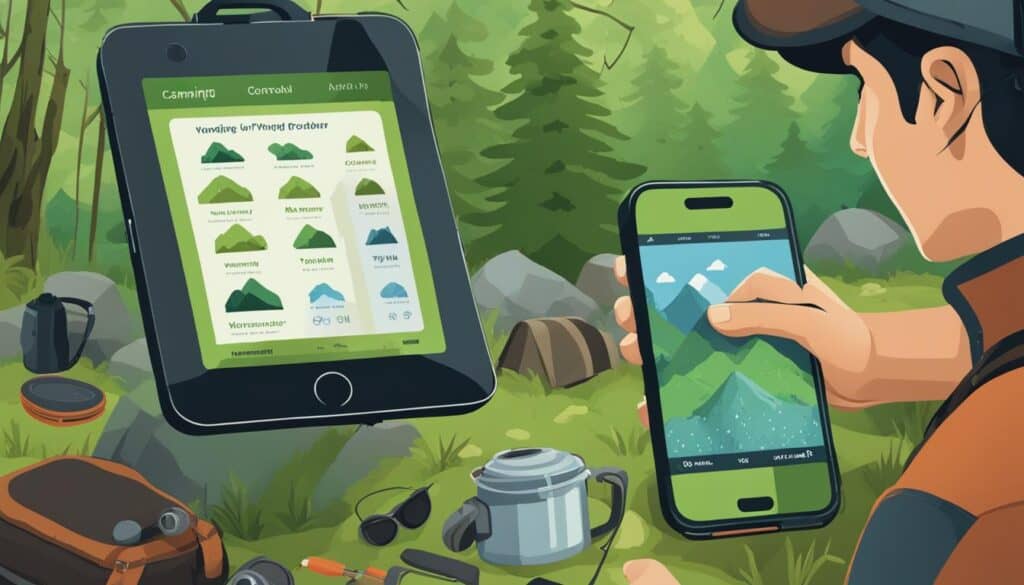
Campfire Cooking in Wet Conditions
Preparing meals that require minimal cooking time
When camping in the rain, it’s crucial to have meals that can be prepared quickly and easily. Opt for dishes that require minimal cooking time, such as pre-packaged dehydrated meals, instant soups, or foil-wrapped dinners.
These options not only save you time but also minimize your exposure to the elements. Additionally, consider prepping some ingredients beforehand, like chopping vegetables or marinating meats at home, so you can quickly assemble them on-site without hassle.
Bringing waterproof matches or a reliable fire starter
In wet conditions, starting a fire can be quite challenging. It’s essential to come equipped with waterproof matches or a reliable fire starter to ensure you won’t struggle igniting your campfire. Waterproof matches are coated with a substance that repels water and allows them to ignite even in damp environments.
Alternatively, there are various portable fire starters available on the market that produce sparks or flames regardless of wet conditions. Prioritize packing these items in a waterproof container to keep them dry and readily accessible.
Creating a makeshift cooking area using tarps or an overhead shelter
To protect your cooking area from rain and wind, it’s helpful to create a makeshift shelter using tarps or an overhead tarpaulin-like cover. This will provide a dry space where you can cook comfortably without worrying about water seeping into your food or dousing your fire pit.
Set up sturdy poles or trees as support for the tarps and securely attach them using bungee cords or ropes. Ensure that the shelter is positioned strategically to prevent smoke from accumulating inside while still allowing proper ventilation for safe cooking.
By following these tips for campfire cooking in wet conditions – preparing quick meals, having waterproof matches/fire starter on hand, and creating a makeshift cooking shelter – you can enjoy delicious meals even when the rain is pouring outside. Remember, adapting your cooking techniques to the weather will make your camping experience more enjoyable and ensure that hunger never dampens the fun.
Embrace the Wetness
When it comes to camping in the rain, embracing the wetness is the key to a successful and enjoyable experience. Rather than focusing on the discomfort of being wet, look at it as an opportunity to connect with nature in a unique way. Remember, rain is an essential part of the natural world and can create a calming and soothing atmosphere.
Dealing with wet conditions starts with proper preparation. Ensure you have the right gear, such as waterproof tents, rainfly, and waterproof clothing. Accept that you will get wet regardless of your gear and focus on the experience rather than the discomfort. By having a positive mindset and embracing the wet conditions, you’ll be able to fully enjoy your rainy camping adventure.
In addition to embracing the wetness, it’s also important to practice good camping hygiene. Quarantine wet gear in designated areas to prevent dampness from spreading. Keep your sleeping bag dry by placing a groundsheet or tarp underneath your tent. Embrace the opportunity to learn new skills, such as starting a fire in wet conditions or cooking hearty meals that warm you from the inside out. By staying adaptable and making the most of the situation, you’ll create lasting memories and forge a deeper connection with the great outdoors.

Remember, rain is a natural part of the camping experience. By embracing the wetness and maintaining a positive attitude, you can make the most of your rainy camping adventure. So, don’t let a little rain dampen your spirits – instead, let it enhance your camping experience and create memories that will last a lifetime.
Entertainment Options during Rainy Camping Trips
Playing card games or board games inside the tent
Picture this – you and your fellow campers huddled together inside the cozy haven of your tent, rain gently pattering on the roof above, and a deck of cards or a thrilling board game spread out before you. Camping in the rain can be an opportunity to rediscover the joy of good old-fashioned games.
Whether it’s a classic card game like Poker or a strategic board game like Settlers of Catan, these activities are not only entertaining but also foster bonding and create lasting memories. Just make sure to choose compact and waterproof options that won’t get ruined by any accidental water spills.
Your might like to also read this article:
Bringing books, magazines, or e-readers
As the rain showers outside create an atmosphere of tranquility, there’s no better time to indulge in some reading. Grab that novel you’ve been meaning to finish or immerse yourself in a captivating magazine. If space is limited in your backpack, consider bringing an e-reader filled with your favorite titles.
With an e-reader, you can have access to countless books at your fingertips without weighing down your pack. Lose yourself in gripping stories or expand your knowledge through informative literature while being serenaded by the rhythmic sound of raindrops on your tent.
Listening to music or podcasts using waterproof speakers
Rainy camping trips offer an opportunity to enjoy music and podcasts in unique ways. With advancements in technology, there are now portable speakers specifically designed to withstand all sorts of weather conditions – including rain! These waterproof speakers allow you to set up an outdoor concert right at your campsite while staying dry under shelter.
Immerse yourself in soothing melodies that complement the rainy ambiance or catch up on thought-provoking podcasts that expand your mind as much as nature expands around you. Just remember to be considerate of your fellow campers and keep the volume at an appropriate level, allowing everyone to enjoy the experience without disturbing the peacefulness of nature.
Incorporating these entertainment options into your rainy camping trips will ensure that even when the weather isn’t cooperating, you’ll still have an enjoyable and memorable time. So gather your favorite games, snuggle up with a captivating book or magazine, or create a rain-inspired playlist for everyone’s listening pleasure.
Rainy days at camp can be transformed into moments of connection, relaxation, and even inspiration. Embrace the beauty of nature in all its forms and let your imagination soar as the raindrops dance around you.
Finding Natural Shelter in the Rain
When camping in the rain, one of the crucial aspects to consider is finding natural shelter to protect yourself and your campsite from the rain. Trees can serve as excellent rain breaks and provide a dry haven amidst the wet conditions. Look for coniferous or leafy trees that can shield your campsite from rain and provide additional comfort and protection. Not only do trees offer natural cover, but they also add to the overall camping experience, creating a serene and peaceful environment.
Advantages of Using Trees as Rain Breaks
- Trees act as a natural barrier, preventing rainwater from directly hitting your campsite and reducing the risk of water seeping into your tent.
- They provide shade, keeping you cooler on sunny days and offering relief from the heat during summer camping trips.
- Trees can offer protection from strong winds, acting as a windbreak and creating a calmer and more peaceful camping environment.
- They enhance the overall aesthetics of your campsite, adding a touch of nature and creating a cozy atmosphere.
When choosing trees as rain breaks, it’s important to consider their location and surrounding factors. Look for trees with sturdy branches and ensure they are situated away from any potential hazards like dead or unstable trees. Additionally, be mindful of the terrain and choose a location with proper drainage to avoid any flooding issues. Remember to always practice Leave No Trace principles and respect the natural environment when using trees as rain breaks.
Another option is to look around for natural features such as trees or large rocks that can act as windbreakers and provide some shelter against harsh weather elements. Positioning your tent close to these natural barriers can significantly reduce wind exposure, minimizing chances of structural damage or discomfort caused by strong gusts.
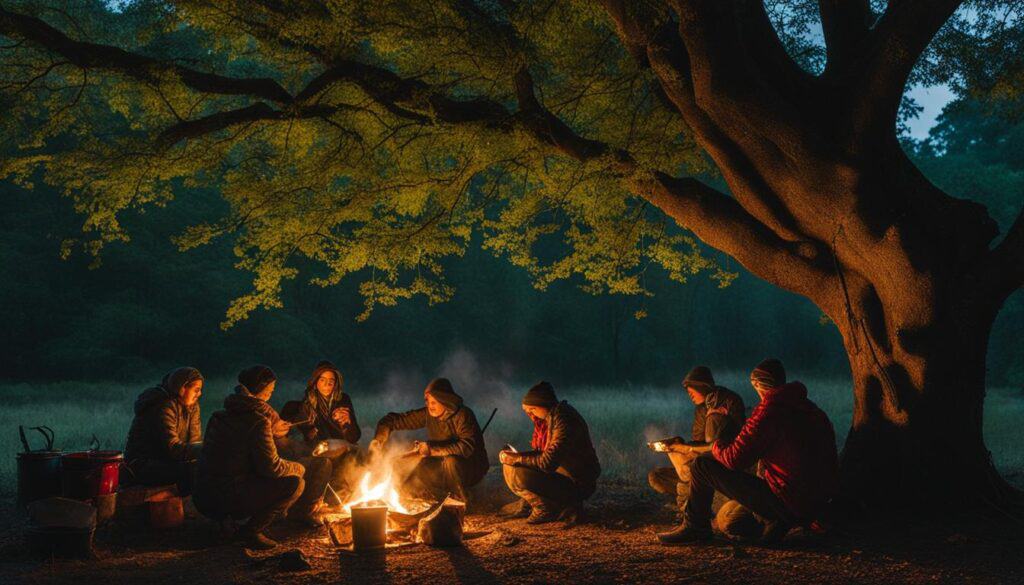
“Camping in the rain can be a memorable experience, and finding natural shelter adds an extra layer of comfort. Utilizing trees as rain breaks not only protects your campsite but also allows you to connect with nature in a unique way.” – Outdoor Enthusiast
Bring an Extra Tarp
One of the essential items to pack for a rainy camping trip is an extra tarp. A tarp can be incredibly versatile and help create a dry space at your campsite. You can use it to set up a sheltered area for cooking, keeping your food and cooking equipment protected from the rain. Additionally, the tarp can provide coverage for setting up your tent, preventing water from seeping through the ground and keeping the inside dry. It’s a practical solution that ensures you have a designated dry space, no matter the weather.
To maximize the effectiveness of your tarp, bring along paracord for easy rigging and flexibility in setting up different configurations. You can tie the tarp to tree trunks or use poles to create a sloping structure that allows rainwater to drain away from your campsite. By strategically positioning your tarp, you can create a dry area where you can relax, cook, and store your gear.
Remember, a tarp is not only useful for creating a dry space, but it can also serve as a barrier between wet ground and your camping gear. Place a tarp underneath your tent to provide an additional layer of protection against ground moisture. You can also use the tarp to fashion a dry area for drying clothes or gear that may have gotten wet during your camping adventures.
Table: Tarp Uses for Rainy Camping
| Tarp Use | Description |
|---|---|
| Creating a Shelter | Set up a covered area for cooking and socializing |
| Protecting Tent | Place a tarp underneath to keep the inside dry |
| Ground Cover | Create a barrier between wet ground and camping gear |
| Drying Area | Use the tarp as a designated spot for drying wet items |
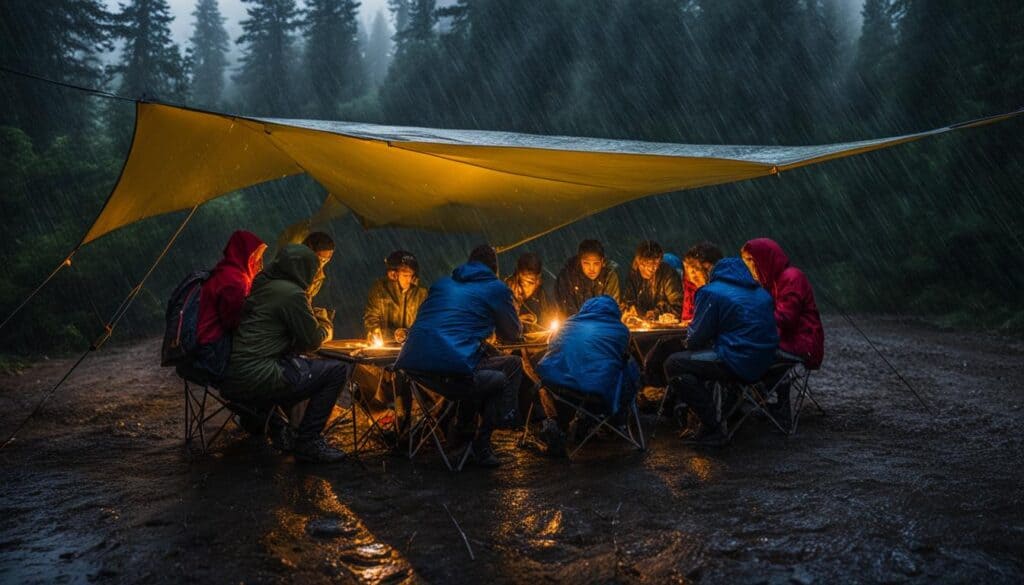
Safety Considerations when Camping in the Rain
Safety is paramount when camping in the rain, as wet conditions can present unique challenges and hazards. It’s crucial to be well-prepared and aware of potential risks. Keep a close eye on weather forecasts, and always have a reliable means of communication and navigation, such as a GPS device or a map and compass. Additionally, stay dry and warm to avoid hypothermia by wearing appropriate clothing and keeping a change of dry clothes on hand. These considerations, along with thorough planning, will help you enjoy your rainy camping adventure safely.
Avoiding areas prone to flash floods or landslides
When planning a camping trip in rainy weather, it’s crucial to consider the safety of your chosen location. Flash floods and landslides can occur during heavy rainfall, so it’s important to avoid areas that are prone to these natural hazards. Research the topography of the camping area and check if there have been any recent incidents of flash floods or landslides.
Avoid setting up camp near rivers, streams, or low-lying areas where water can accumulate rapidly. Instead, choose higher ground that provides adequate drainage for rainwater.
Conclusion
Camping in the rain is not just about surviving the wet weather; it’s about embracing the adventure and making the most of the experience. By following these tips and recommendations, you can ensure a successful and enjoyable rainy camping trip.
Start by preparing yourself with the right gear, such as a waterproof tent, rain gear, and extra tarps. Choose a campsite that can withstand and protect you from the rain, whether it’s an established campsite in a national park or a natural shelter like trees or canopies.
Don’t forget to dress appropriately with a well-thought-out layering system and invest in a reliable waterproof jacket. Brighten up your rainy nights with string lights or solar lanterns to create a cozy atmosphere.
Remember to check the weather forecasts and prioritize safety. Camping in the rain may not always be possible if there are thunderstorms or severe weather conditions. Stay positive, embrace the wetness, and make the most of your rainy camping adventure!
FAQ
What gear do I need for camping in the rain?
To camp in the rain, you’ll need a waterproof tent with a rainfly, a tent with a vestibule for added coverage, waterproofing spray, tarps, ground cloths, waterproof containers, rain gear, towels, and adequate lighting.
How should I choose a campsite for camping in the rain?
When camping in the rain, look for established campsites in national parks that offer designated tent pads and infrastructure. Consider using a tree tent or finding natural shelters like trees or large leafy canopies to protect yourself from rain. Choose a safe campsite with proper drainage to avoid flooding.
What should I wear for camping in the rain?
Dress in layers with moisture-wicking materials like wool base layers and polyester mid-layers. Invest in a reliable and waterproof jacket with taped seams and ventilation features. Don’t forget a wide-brim hat, extra socks, and waterproof boots.
How can I brighten up my camping experience in the rain?
Use string lights to create a cozy ambiance around your campsite or inside your tent. Consider solar lanterns to illuminate your campsite at night. Multi-color lanterns can add vibrancy to your rainy nights.
Should I still go camping if there’s a forecast for thunderstorms?
It’s best to postpone your camping trip if there’s a forecast for thunderstorms or severe weather conditions. Camping during thunderstorms can be dangerous due to lightning and strong winds. Safety should always be a priority.
How can I embrace camping in the rain?
Accept that you will get wet regardless of your gear and focus on the experience rather than the discomfort. Look for natural shelters like trees or rain breaks to stay dry. Quarantine wet gear in designated areas to prevent dampness from spreading.
What should I do if it’s raining during my camping trip?
Find natural shelter like trees or other rain breaks to set up your camp. Use an extra tarp to create a dry space for your tent and kitchen. Tarps can also be used for drying clothes and gear.
How can I enhance my camping experience in the rain?
By following these tips and recommendations, such as packing the right gear, choosing the right campsite, dressing appropriately, and brightening up your nights, you can fully embrace the experience of camping in the rain.

